1 Lb Raw Ground Beef Equals How Many Cups Cooked
A food storage list for 1 year. It sounds simple enough…going through a list of food to acquire in order to set yourself up with food storage for a year. However, let me tell you this, there are a LOT of ways to go about this. I've done it for my household of two. Actually I've acquired more than that. Over time. And I have learned lots of lessons in the process. Some, the hard way.
Read to the end. I've inserted a number of internal links to other articles too. Come back to this one and continue to formulate your own plan…
My first serious attempt at this. It was many years ago. I had lots of questions. I knew this was something the Mormons did, and/or still do. So I figured I would start there first, for ideas. Maybe a list!
Among the many resources for sorting out your survival preparedness regarding long-term food storage is the LDS church (Latter-day Saints).
Written on the cover of the LDS Preparedness manual is a Proverb which reads,
"The prudent see danger and take refuge, but the simple keep going and suffer for it."
This seems to generally sum up the preparedness movement whereby critical-thinking people are preparing for potential disruptions ahead.
So I found and purchased the following preparedness guide. Actually it was an older version of the the following manual, although I did eventually buy this one too:
LDS Preparedness Manual by Christopher Parrett
(view on amzn)
Note: The manual itself is not an official publication of the Church of Jesus Christ of Latter Day Saints. However, I have confirmed their recommendations for a 1 year food supply, per adult, to match current recommendations on their official website. Updates referenced below…
I have LOTS of recommendations about FOOD STORAGE on this site. Even if you're looking for a food storage list for 1 year, or 3 months, I recommend that you check out the Food & Kitchen category up in the menu listing. Use our Search function too.
In general I go way beyond what's listed here. I highly suggest diversification rather than bulking up too much on just grains, legumes, and other staples (although important too!). Although I absolutely do utilize storage of those dry goods, I also include much more and lots of variety. Again, check out my other articles…
With that said, I wanted to post specifically about the food storage list for 1 year as recommended within the manual linked above. It simply provides another outlook. Maybe a place to start.
1 Year Food Supply
Here is that food storage list for 1 year of bare minimum food storage for one adult.
Consider starting with this as your essentials. And then add additional other food categories for diversification and personal preferences.
Grains (400 lbs)
Grains: Wheat Berries. Oats. Rice. Corn. Rye. Barley. Primarily, we're talking about wheat berries, rice, oats, or any other dry grains.
LDS recommends a combination thereof, adding up to 400 pounds per adult. This alone will provide a little over a pound of grain per day per adult for a year. That's about 1,500 calories (uncooked)!
Wheat berries will provide daily bread. Wheat berries store well for decades. They must be ground (milled) into flour in order to make bread. But it's not that difficult if you have the right tools. We've done this for years…
[ Read: Benefits of Milling Your Own Flour From Wheat Berries ]
You can buy many types of grains that are professionally packaged in sealed buckets / pails for long term storage. There are many brands. I've used Augason Farms (no affiliation – I just like their product), among others. However, these days, there are sporadic inventory shortages of wheat. Probably due to recent demand and current events.
Update: I've adjusted the links to what is currently available. "Wheatland" Hard White Wheat from Utah/Idaho.
25 LBS pail – Wheat Berries
10 LBS pail – Oats
(amzn)
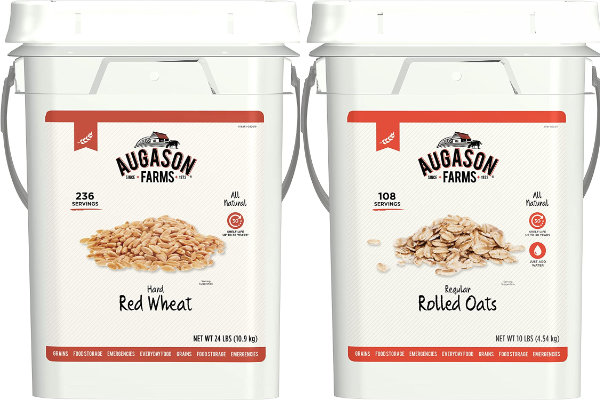
Or you can purchase bulk grains and fill your own buckets. I have done this, as well as purchasing ready made pails such as above. Doing it yourself is more work though. And you still need to buy empty buckets, lids, Mylar bags, oxygen absorbers…
BULK WHEAT:
25 Pounds Hard White Wheat Berries • Family Farmed in Washington State
(their storefront on amzn)
Tip: 25 pounds of wheat berries will perfectly fit in a 5 gallon bucket. Actually, my experience is just over 30 pounds…
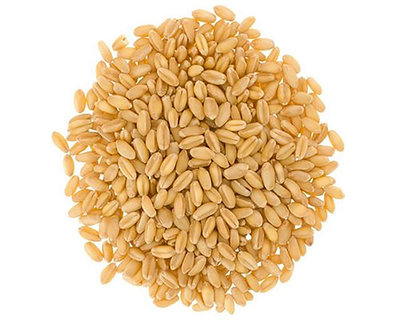
Tip: Unless your family already eats 100% whole wheat homemade bread, white flour should be used in the transition process to whole wheat. Adding rye flour (10%) helps make wheat bread a more complete protein.
[ Read:
How-to Seal Mylar Bags in 5 Gallon Buckets
Choosing The Best Hand Grain Mill (Flour Mill)
How Many Pounds of Flour or Wheat Berries To Make Bread
Gamma Seal Lids – What They Are and Why You Want Them
Beans & Legumes (60 lbs)
(Bare minimum LDS church reduced from 90 to 60 lbs in 2002)
At first, I bought various types of dry beans in bulk, and sealed them in 5 gallon buckets. However, later on, and after consuming some of that storage, I decided to do something different. I simply purchased the typical 1 pound bags of beans in the grocery store. I chose a variety of the one's we like best. Individually vacuum-sealed, and kept in plastic storage bin(s).
[ Read: How I Store Dry Beans For Long Term ]
Tip: Rice is rich in starch, and an excellent source of energy.Beans are rich in protein, and contain other minerals. The consumption of the twotogether provides ALL the essential amino acids, and it is no wonder that this combination is a staple of many diets throughout the world.
[ Read: Rice & Beans – A Survival Combination ]
Milk-Dairy products (16 lbs)
(Bare minimum LDS church reduced from 75 to 16 lbs in 2002)
I will advise you as to what I buy. A powdered milk that actually tastes good! Seriously. We've been buying this stuff for years. Packaged in sealed #10 cans. It has a25 year shelf life unopened, and a one to two year shelf life if opened.
Each can weighs 3.5 pounds and will make about 6 gallons (depends how strong you mix it). If your household goes through a gallon of milk a week, that's about 9 cans. So just do the math for your own household for a year.
Augason Farms Morning Moo's Low Fat Milk Alternative – Makes 6 Gallons
(view on amzn)
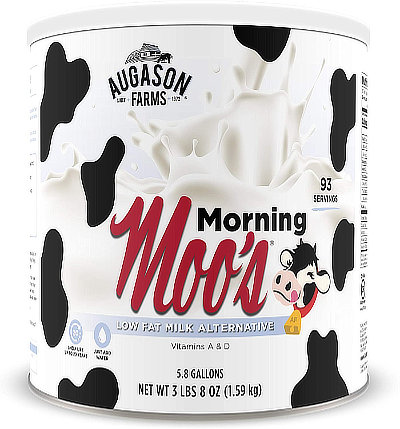
[ Read: The Benefits of Powdered Milk ]
If you're looking for real nonfat dry milk, rather than the alternative above, Augason also supplies the following:
Country Fresh 100% Real Instant Nonfat Dry Milk
(Augason Farms on amzn)
As far as other dairy products, we keep some #10 cans of powdered butter, powdered cheese, and powdered eggs (although now we have chickens). Be aware that these won't last as long as the powdered milk. I believe most manufacturers indicate about 5 years shelf life. Check the label. So be sure to use/consume and rotate so you don't waste it.
Augason Farms Dried Whole Egg Product
(Augason Farms on amzn)
We also freeze some (though not too much) block cheese in a chest freezer. Be aware that the cheese may be a bit crumbly after having been frozen for some time.
Meats (20 lbs)
(Bare minimum reduced by LDS church to ZERO in 2002)
Oh my, I disagree with LDS on this one! I am a carnivore (grin). You can do what you want, but I keep at least one large chest freezer filled with beef. Another has pork and chicken.
Yes, I know what you're going to say… what if the power goes out or grid-down? That's a valid concern for preparedness! Shortly after I moved to my current homestead, I built a solar power separate off-grid system. Enough to run all my home 'essentials'. So, I'm less worried about that. Obviously a generator will power it for awhile. Just not long term.
[ Read: How-to Keep Chest Freezer Running During a Power Outage ]
[ Read: Frozen Vacuum Sealed Meat – How Long Is Storage Life In The Freezer ]
Freeze Dried Meat. It's very expensive. I did purchase a quantity of this years ago. Don't make the initial mistake I made which was "meat" that was actually a flavored soy product. Textured Vegetable Protein (TVP). Yuck (in my opinion). Get the real deal. 100% meat. Again, it's very expensive. But I diversify all my food storage.
Example: Mountain House Chicken or Beef
(amzn)
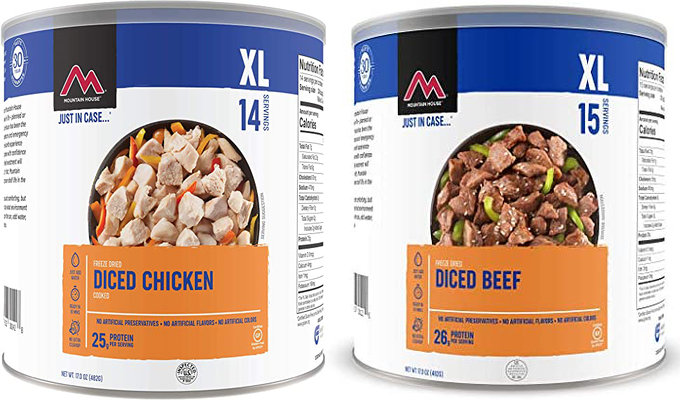
Fats / Oils (20 lbs)
Official LDS guidelines for Cooking Oils: 10 Quarts
This group can boost the calories one is getting from food storage products, and supply essential fatty acids.
I keep three types of oils. Olive oil. Avocado oil. Coconut oil.
Store these oils in a dark place out of direct sun – for best operating shelf life while in use. I keep mine in the cupboard.
Oils like olive or avocado will begin to go "off" in taste after about one year. Eventually they will go rancid. So, I keep my extra in a chest freezer. That's the way to store cooking oils for long term storage if you can.
The bottle size that I get (olive & avocado oil) are around 50 ounces. That's about 3 pounds each. So, LDS is saying about 6 or 7 of those. Maybe three of each? Sounds about right…
I've not had a problem with storage of coconut oil at room temp. It will be somewhat solid (but pliable) when its cool. It will become more liquid when room temperature gets fairly warm. But that's okay.
Sugars and/or Honey (60 lbs)
What are the size of typical bags of sugar these days? Seems like they keep getting smaller. Used to be 5 pounds. Now I believe it's 4 pounds (or maybe less?).
Anyway, you're looking at about 15 of those bags. It lasts forever, so don't worry. I keep some in a plastic storage bin. I also have bulk sugar in 5-gallon pail.
Tip: Gamma Seal Lids! They're awesome!
[ Read: Gamma Lids – What They Are, And Why You Want Them ]
HONEY. It lasts forever. Get the REAL honey. Not the corn syrup. BIG difference.
Salt (8 lbs)
Our body needs salt. Not only does it add flavor, but it's part of keeping your electrolytes in check too. It can also be used to help preserve other foods. It's simple enough to purchase more salt. I also like Kosher salt (larger granules) for my steaks. Delish.
I really like the following Redmond natural salt from Utah. Conveniently, it also comes in a 10 pound pail.
Redmond Real Sea Salt – Natural Unrefined Gluten Free Fine, 10 Pound Bucket
(Redmond on amzn)
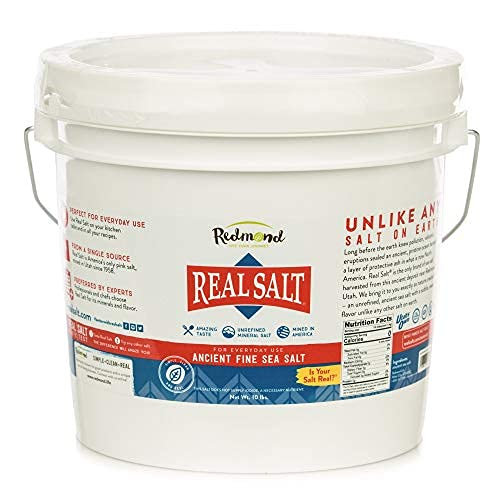
Fruits / Vegetables (90 lbs)
(Bare minimum reduced by LDS church to ZERO in 2002, only because they consider it not initially essential to supply yourself with first.) However, this is their statement…
The First Presidency recommends that Church members "begin their home storage by storing the basic foods that would be required to keep them alive if they did not have anything else to eat." After they have a year's supply of the basics, they may then add other foods they are accustomed to eating regularly. (See First Presidency letter, Jan. 20, 2002.)
You gotta have yur veggies. Here's a thought… Grow a garden! There's your vegetables!
For example, the last two years I had a wildly successful crop of bell peppers (green, red) and jalapenos. We saved enough to last us more than a year, easily… They're vacuum sealed in pint size bags, a perfect meal size.
[ Read: Brandywine Tomatoes, Jalapeno's, and Bell Pepper Bumper Crop ]
Carrots! Again, we had a ton of them from our garden. So, we canned them with our pressure canner. Oh my, oh my, they are so good.
[ Read: How to Can Carrots ]
Oh, by the way, potatoes are the most calorie-dense vegetable. Important information to know for survival!
[ Read: Garden Vegetable Calories ]
Okay, with that said (grow your own vegetables), we also keep a quantity of various store-bought canned vegetables. Remember to rotate through these within a year or two. Also, we have a quantity of various dehydrated and freeze-dried fruits and vegetables in #10 cans. Diversification!
Auxiliary foods (weight varies)
Things like herbs and spices. Ingredients to make various sauces. Your condiments like mustard, ketchup, L&P Worcestershire, Franks Red Hot! Etc..
There are lots of other complimentary food items. You know what they are…
Chocolate? (grin) What about a chest freezer full of ice cream?! (maybe not such a good idea)
Note:
The LDS manual recommended the following:
For adults engaged in manual labor multiply by 1.25-1.50
For an average adult Female – multiply the weight by 0.75
Children ages 1-3 multiply by 0.3
For children ages 4-6 multiply by 0.5
For children ages 7-9 multiply by 0.75
Food Storage List For 1 Year Food Supply – Calories
As indicated above, the LDS are now suggesting the following absolute bare minimums for each adult. I did the math to portion these quantities per day, just to get an idea of what we're talking about…
These basic ingredients amount to approximately 2,600 calories per day. Or, nearly 950,000 calories for one year.
For me personally, I would make adjustments to this list. Meat. I would reduce the carbohydrates and increase the meat/protein. But again, this is basic. It will help get you started on all this.
Grains 400 lbs.
17.5oz / day (~ 1750 calories)
Beans 60 lbs.
2.6oz / day (~ 260 calories)
Oils 20 lbs.
0.87oz / day (~ 220 calories)
Sugar 60 lbs.
2.63oz / day (~ 280 calories)
Salt 8 lbs.
0.35oz / day (0 calories)
Milk-Dairy 16 lbs.
0.70oz / day (~ 100 calories)
5-gallon buckets will hold about 33 pounds of wheat berries, rice or other grains. They're all similar in that way. This means you would need about 12 (5-gallon) buckets of these grains for each adult in your family. This will give you an idea of the space you would need for this.
[ Read: How Much Wheat in a 5 Gallon Bucket – Pounds, Calories, #Loaves Bread ]
60 pounds of beans will fit in two 5-gallon buckets. Or, if you buy 1-lb bags, these will fit in a couple of plastic storage bins of sufficient size (helps keep critters out).
Daily Food
Dividing 400lbs by 365days, equals out to 1.1 lbs, or just over 1 lb of grain, per person, per day. That is approximately 2 cups of unground grain to cover your breakfast lunch and dinner. Some might be rice. Some might go towards making bread. You will be using this to make bread, pancakes, biscuits, rice & beans, or whatever…
Dividing 60lbs by 365, this works out to 0.16 lbs of beans per day, or 2.6oz — approximately 3/4 cup (uncooked).
This is not much food, folks. Get the basics, then immediately begin to diversify further. Maybe add more kinds of grain, canned and/or dehydrated vegetables and fruit, MEAT, etc. to add variety and provide more than the minimal survival diet.
It's a process. Diversify!
I have lots of articles here on this subject. Again, there's lots of ways to go about this. You could start buying kits like the Augason Farms 30-day supply, for example. Or their Lunch and Dinner kits. And Breakfast kits.
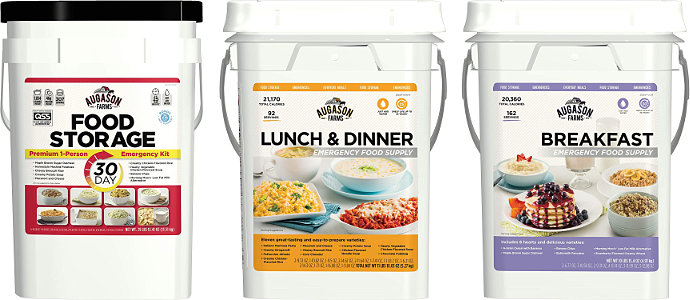
Or, you could start building your own. (Or both).
Source: https://modernsurvivalblog.com/survival-kitchen/bare-minimum-food-storage-for-one-year/
0 Response to "1 Lb Raw Ground Beef Equals How Many Cups Cooked"
Postar um comentário